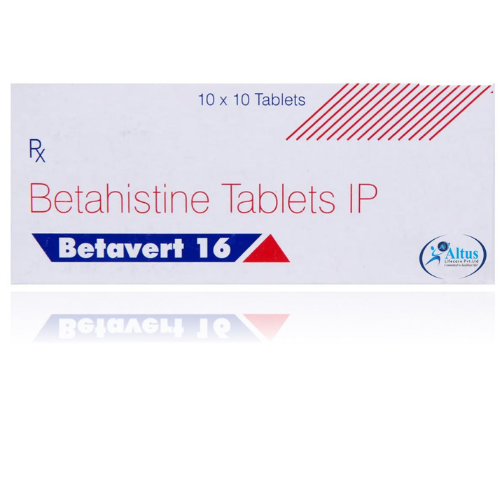Need Help? Call us at: +91 9002 1002 33 (9:00 AM - 5:00 PM)
Email us: info@altuslifecares.com
No products in the cart.
Return To ShopNo products in the cart.
Return To Shop$47.10 – $113.10Price range: $47.10 through $113.10
Betavert 16 Tablet (Betahistine 16mg) comes under the category of medications called ‘antihistamine anti-vertigo medication’, primarily indicated in the treatment of Meniere’s disease and its symptoms including dizziness (vertigo), ringing in the ears (tinnitus), feeling sick (nausea), and difficulty in hearing.
Call : +91 9002 1002 33
| COUNTRY OF ORIGIN | India |
|---|---|
| DOSAGE FORM | Tablets |
| EQUIVALENT BRAND | Serc |
| GENERIC NAME | Betahistine |
| INDICATION | Vertigo, Meniere’s disease |
| MANUFACTURER | Sun Pharmaceutical Industries Ltd |
| PACKAGING | 10 tablets in 1 strip |
| COMPOSITION | Betahistine (16mg) |
Betavert 16 Tablet is used to prevent and treat a disorder of the inner ear known as Ménière’s disease. The symptoms include dizziness (vertigo), ringing in the ears (tinnitus), and loss of hearing, probably caused by fluid in the ear. This medicine helps relieve the symptoms by reducing the amount of fluid.
Betavert 16 Tablet should be swallowed whole with water and taken at the same time(s) each day to get the most benefit. Your doctor will decide what is the correct dose to relieve your symptoms and how often you need to take it. You may need to take this medicine for several months and you should take it for as long as prescribed by your doctor, even if you start feeling better.
The most common side effects include headache, feeling sick, and indigestion (dyspepsia). You may also get stomach pain and bloating. Taking the medicine with food can help reduce stomach problems.
Before taking this medicine, you should talk to your doctor if you have a stomach ulcer, asthma, or high or low blood pressure. You must also tell him/her what other medicines you are taking, to make sure you are safe. Also speak to your doctor if you are pregnant, trying to become pregnant, or breastfeeding.
Betahistine is a medication that plays a crucial role in managing a variety of inner ear and balance disorders. Often used to treat conditions like Meniere’s disease, vertigo, and other vestibular disorders, Betahistine helps restore equilibrium to those who suffer from the disorienting symptoms of dizziness, tinnitus, and nausea. This medication works by enhancing blood flow to the inner ear, thus improving its function and reducing the frequency and severity of vertigo attacks. As with any medication, it’s important to use Betahistine under the guidance of a healthcare professional to ensure it is both safe and effective. In this blog, we will delve into the world of Betahistine, exploring its applications, potential benefits, and the considerations to keep in mind when seeking relief from balance-related issues.
Betahistine 16 mg is a specific dosage of a medication that holds a key role in alleviating inner ear and balance-related issues. It is commonly prescribed for conditions such as Ménière’s disease and vertigo, where dizziness, tinnitus, and nausea can significantly disrupt one’s life. The 16 mg variant of Betahistine provides a carefully measured dose to help manage these symptoms effectively. This medication operates by enhancing blood flow to the inner ear, contributing to improved function and a reduction in the severity and frequency of vertigo attacks. To use Betahistine 16 mg safely and effectively, it’s essential to consult with a healthcare professional. In this blog, we’ll take an in-depth look at Betahistine 16 mg, exploring its potential benefits, applications, and important considerations for those seeking relief from inner ear and balance issues.
Betahistine tablets are a vital component in the management of inner ear and vestibular disorders, designed to alleviate the debilitating symptoms of vertigo, tinnitus, and dizziness. These tablets, containing the active ingredient Betahistine, are often prescribed for conditions such as Ménière’s disease, where maintaining balance and reducing the frequency of vertigo attacks is paramount. Betahistine operates by improving blood flow to the inner ear, which in turn can lead to enhanced inner ear function. For those considering Betahistine tablets as a part of their treatment plan, it is crucial to consult with a healthcare professional to determine the proper dosage and ensure safety and effectiveness. In this blog, we will unravel the role of Betahistine tablets, exploring their applications, potential benefits, and the considerations involved in finding relief from inner ear and balance-related challenges.
Betavert Tablet improves blood flow to the inner ear which reduces the pressure of excess fluid there. It is this pressure that is thought to cause the symptoms of nausea, vertigo (dizziness), tinnitus (ringing in your ears), and hearing loss in people who have Ménière’s disease. This medicine makes the symptoms milder and reduces the number of times you get the symptoms.
It will be more effective if you take this medicine regularly as prescribed so try not to miss doses. It may take a couple of weeks before you notice any improvements but keep taking it, even if you do feel better until your doctor advises it is safe to stop.


Alcohol

Pregnancy

Breast feeding

Driving

Kidney
 Liver
Liver| Pack Size | 100 Tablet/s, 150 Tablet/s, 300 Tablet/s |
|---|

Benoquin 40 Cream | Monobenzone 40%



Aziderm 10% Cream 15gm | Azelaic Acid 10%
Shipping at Discounted Price
Return Within 30 Days
Safe & Secure Payment
Contact 24 Hours Day
From: $37.50


From: $52.50
You cannot copy content of this page.
Magnolia (verified owner) –
“Post-surgery recovery. Recovering from surgery is challenging, but this product has made the process more bearable by easing nausea.”
Arya (verified owner) –
“Tackles nausea from anxiety. When stress takes its toll on my stomach, this product helps calm the queasiness and restore comfort.”
Josie (verified owner) –
“Happy stomach on the go. This product has become my travel buddy, providing relief from nausea during road trips and flights.”
Adeline (verified owner) –
“Long-lasting relief. I love that a single dose can keep nausea or vomiting at bay for an extended period.”